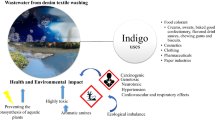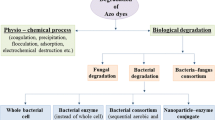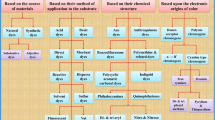Abstract
The objective of this work was to optimize the decolorization of methylene blue dye wastewater by Penicillium P1. The influencing factors included initial methylene blue concentration, initial pH value, salinity and inoculation percentage of penicillium spores. The decolorization rate was optimized by response surface center composite design methods. The optimal optimization condition was methylene blue concentration 50 mg/L, pH value 3.61, salinity 3.7%, and inoculation percentage 3.21% (When the MSM was 100 ml), the predicted decolorization rate of methylene blue 85%. The UV and the FTIR spectrum analysis showed that the structure of methylene blue changed during the process of decolorization of methylene blue by Penicillium P1.







Similar content being viewed by others
References
Shabaan OA, Jahin HS, Mohamed GG (2020) Removal of anionic and cationic dyes from wastewater by adsorption using multiwall carbon nanotubes. Arab J Chem 13:1329–1336. https://doi.org/10.1016/j.arabjc.2020.01.010
Parlayc E, Pehlivan E (2020) Biosorption of methylene blue and malachite green on biodegradable magnetic Cortaderia selloana flower spikes: modeling and equilibrium study. Int J Phytoremediat 1:1–15. https://doi.org/10.1080/15226514.2020.1788502
Couto SR (2009) Dye removal by immobilized fungi. Biotechnol Adv 27:227–235. https://doi.org/10.1016/j.biotechadv.2008.12.001
Chen L, Wang G, Wu S, Xia Z, Zhou S (2019) Heavy metals in agricultural soils of the lihe river watershed, east china: spatial distribution, ecological risk, and pollution source. Int J Environ Res Public Health 16:2092–2094. https://doi.org/10.3390/ijerph16122094
Saratale RG (2011) Outlook of bacterial decolorization and degradation of azo dyes: a review. J Taiwan Inst Chem Eng 42:138–157. https://doi.org/10.1016/j.jtice.2010.06.006
Telke AA, Kalyani DC, Dawkar VV, Govindwar SP (2009) Influence of organic and inorganic compounds on oxidoreductive decolorization of sulfonated azo dye c.i. reactive orange 16. J Hazard Mater 172:298–309. https://doi.org/10.1016/j.jhazmat.2009.07.008
Li M, Meng X, Wang X (2001) Adsorption and degradation of three reactive dyes by Penicillium sp. China Environ Sci 21:449–449. https://doi.org/10.3321/j.issn:1000-6923.2001.05.015
Chen Z, Chen H, Pan X (2015) Investigation of methylene blue biosorption and biodegradation by Bacillus thuringiensis 016. Water Air Soil Poll 226:146. https://doi.org/10.1007/s11270-015-2417-3
Conneely A, Smyth WF, Mcmullan G (2002) Study of the white-rot fungal degradation of selected phthalocyanine dyes by capillary electrophoresis and liquid chromatography. Anal Chim Acta 451:259–270. https://doi.org/10.1016/S0003-2670(01)01415-5
Guler UA, Sarioglu M (2013) Single and binary biosorption of Cu(II), Ni(II) and methylene blue by raw and pretreated Spirogyra sp.: equilibrium and kinetic modeling. J Environ Chem Eng 1:369–377. https://doi.org/10.1016/j.jece.2013.05.017
Tamboli DP, Kagalkar AN, Jadhav MU, Jadhav JP, Govindwar SP (2010) Production of polyhydroxyhexadecanoic acid by using waste biomass of sphingobacterium sp. atm generated after degradation of textile dye direct red 5b. Bioresour Technol 101:2421–2427. https://doi.org/10.1016/j.biortech.2009.11.094
Lade HS, Waghmode TR, Kadam AA (2012) Enhanced biodegradation and detoxification of disperse azo dye Rubine GFL and textile industry effluent by defined fungal-bacterial consortium. Biodeter Biodegrad 72:94–107. https://doi.org/10.1016/j.ibiod.2012.06.001
Shawabkeh RA, Tutenji MF (2003) Experimental study and modeling of basic dye sorption by diatomaceous clay. Appl Clay Sci 24:111–120. https://doi.org/10.1016/S0169-1317(03)00154-6
Gbenle GO, Osuntoki AA, Olukanni OD (2009) Decolourization of azo dyes by a strain of micrococcus isolated from a refuse dump soil. Biotechnology 8:442–448. https://doi.org/10.3923/biotech.2009.442.448
Parshetti GK, Parshetii SG, Telke AA (2011) Biodegradation of crystal violet by Agrobacterium radiobacter. J Environ Sci 23:1384–1393. https://doi.org/10.1016/s1001-0742(10)60547-5
Waghmode TR, Kurade MB, Khandare RV, Govindwar SP (2011) A sequential aerobic/microaerophilic decolorization of sulfonated mono-azo dye Golden yellow HER by microbial consortium GG-BL. Int Biodeterior Biodegr 65:1024–1034. https://doi.org/10.1016/j.ibiod.2011.08.002
Ahmadi R, Rezaee A, Hossini H (2015) Optimization of Cr (VI) removal by sulfate reducing bacteria using response surface methodology. Desalin Water Treat 57:11096–11102. https://doi.org/10.1080/19443994.2015.1041055
Liu J, Chen Y, Xu R, Jia Y (2013) Screening and evaluation of biosurfactant-producing strains isolated from oilfield wastewater. Indian J Microbiol 53:168–174. https://doi.org/10.1007/s12088-013-0379-y
Liu J, Xue J, Wei X, Su H, Xu R (2020) Optimization of Cr6+ Removal by Bacillus subtilis Strain SZMC 6179J from chromium-containing soil. Indian J Microbiol 60:430–435. https://doi.org/10.1007/s12088-020-00886-3
Noraini CHC, Morad N, Norli I, Teng TT, Ogugbue CJ (2012) Methylene blue degradation by Sphingomonas paucimobilis under aerobic conditions. Water Air Soll Poll 223:5131–5142. https://doi.org/10.1007/s11270-012-1264-8
Mirazimi SMJ, Rashchi F, Saba M (2013) Vanadium removal from roasted LD converter slag: optimization of parameters by response surface methodology (RSM). Sep Purif Technol 116:175–183. https://doi.org/10.1016/j.seppur.2013.05.032
Ebrahimi B, Shojaosadati SA, Ranaie SO, Mousavi SM (2010) Optimization and evaluation of acetylcholine esterase immobilization on ceramic packing using response surface methodology. Process Biochem 45:81–87. https://doi.org/10.1016/j.procbio.2009.08.007
Zhang T, Oyama TK, Horikoshi S, Hidaka H, Zhao J, Serpone N (2002) Photocatalyzed N-demethylation and degradation of methylene blue in titania dispersions exposed to concentrated sunlight. Sol Energ Mat Sol C 73:287–303. https://doi.org/10.1016/S0927-0248(01)00215-X
Author information
Authors and Affiliations
Corresponding author
Additional information
Publisher's Note
Springer Nature remains neutral with regard to jurisdictional claims in published maps and institutional affiliations.
Rights and permissions
About this article
Cite this article
Liu, J., Su, H., Xue, J. et al. Optimization of Decoloration Conditions of Methylene Blue Wastewater by Penicillium P1. Indian J Microbiol 62, 103–111 (2022). https://doi.org/10.1007/s12088-021-00982-y
Received:
Accepted:
Published:
Issue Date:
DOI: https://doi.org/10.1007/s12088-021-00982-y




